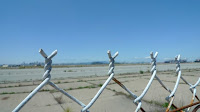Alameda is a conflicted island. On one side, the city of Alameda with picturesc Victorian houses, on the other side a decommissioned Navy base, that is in the process of being turned over to the city of Alameda.
We heart about a vodka distillery in the former Navy yard some time ago. It was time to check it out, when we realized that there is a winery next door.
On our way to the hangar area, where the spirits are located, the conflicted nature of the former base became apparent. On one side of the road an upscale development with beautiful landscaping. On the other side military housing behind barbwire. Abandoned warehouses, laboratories, factories. Streets so wide that it was unclear where the middle divider was. And at the end, a row of old hangars and a beautiful view of San Francisco.
Our first stop was at the Rock Wall Wine Company, an urban winery that houses Rock Wall Wines, and a number of additional boutique wineries that don't have their own wine making facilities.
The tasting room isn't actually a room. It is a table on the side of a huge hangar, surrounded by wine barrels. We were lucky that the "door" was open, and we could enjoy the view of the city.
The wines were also not to be missed. We especially liked the Rock Wall Zinfandels, and the 2007 JRE Napa Valley Cab (and no, that's not Java Runtime Environment!).
Right next door is St. George Spirits. Having never been to a vodka tasting, I had no idea what to expect.
St. George fortunately had quite an array of spirits, from the famed Hangar One vodka via Rasberry and peach spirits to Absinthe.
 Some of the infused vodkas were quite delicious, especially the mandarin flowers, and the winter mix (orange with spices). I'll definitely try to make the Buddha's hand infused vodka, like limoncello without the peelingo of the lemons, and without the sugar.
Some of the infused vodkas were quite delicious, especially the mandarin flowers, and the winter mix (orange with spices). I'll definitely try to make the Buddha's hand infused vodka, like limoncello without the peelingo of the lemons, and without the sugar.Never having had Absinthe, I was curious what to expect. To my surprise, it just tastes like a high class pastis. The defining ingredient for Absinthe is wormwood, which grows in St. George's front yard.











